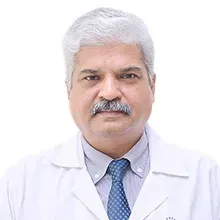Overview of Pancreatic Cancer Treatment
Pancreatic cancer develops in the pancreas, an organ located behind the stomach. The pancreas has two most important functions: digestion of food and regulating blood sugar levels. When cancer forms in the pancreas, it disturbs its normal functioning and leads to various problems like indigestion, nausea, vomiting, jaundice, and diabetes. Whipple procedure is a surgical treatment for pancreatic cancer, but it can also be used with other treatments like chemotherapy and radiation therapy.
The cost of Pancreatic Cancer Treatment in India starts from ₹ 3,35,000 to ₹ 7,40,000. The treatment cost varies due to factors like the facilities of the hospital, doctor's fees, skill and experience of the surgeon, diagnostic procedures, type of surgery, and costs for chemotherapy and radiation therapy. India provides medical care and services that match the standards of the best hospitals globally.
Types of Pancreatic Cancer Treatment in India
- Chemotherapy
- Targeted drug therapy
- Radiation therapy
- Palliative therapy
- Surgery
Chemotherapy
Chemotherapy uses drugs to limit the growth of cancer cells. It can be taken by mouth or by the injections that run in blood and kill any cancer cell found in the body. Combinations of drugs are usually used rather than only one drug.
Targeted Drug Therapy
These drugs attack the cancer cell environment in which they grow and kill them. Target drug therapies block the nutrition of cancer cells which ultimately leads to the death of cells.
Radiation Therapy
The radiations of x-rays are used to kill the cancer cells by any external or internal source. External radiation therapy involves a machine outside the body that throws a beam of x-rays on a tumor through the skin. But in internal radiation therapy or BRACHYTHERAPY, the radioactive material is placed at the tumor site.
Chemoradiation therapy also used to increase the effect of each other.
Palliative Therapy
When the cancer becomes widespread and is unable to be treated. Palliative care is used to control the symptoms experienced by the patient. It could be a surgery like biliary bypass or gastric bypass that opens the block ducts or it could be a medicine for the pain.
Surgery
Some surgical procedures can be used:
Whipple procedure: in this, the bile duct, the head of the pancreas, the gallbladder, a portion of the stomach, and the small intestine are all removed. Some cells are spared for the functioning in this procedure.
Total pancreatectomy: in this the entire pancreas, a portion of the stomach, a portion of the small intestine, the common bile duct, the gallbladder, the spleen, and adjacent lymph nodes are removed
Distal pancreatectomy: it is a surgery to remove both the pancreas' body and tail. If cancer has gone to the spleen, then it may also need to be removed.
Pancreatic Cancer Treatment Cost in India
Pancreatic Cancer Treatment Cost in India ranges from ₹ 3,25,000 to ₹ 4,40,000. In comparison to the most developed countries in the world, the cost of pancreatic cancer therapy is low. The cost of cancer therapy can be expensive but cancer treatment in India is quite affordable.
Types of Pancreatic Cancer Treatment and Cost in India
| Pancreatic Cancer Treatment Cost in India |
Min in INR |
Max in INR |
| Chemotherapy |
₹ 39,500 |
₹ 55000 per session |
| Whipple Procedure |
₹ 5,25,000 |
₹ 6,19,000 |
| Distal Pancreatectomy |
₹ 3,00,000 |
₹ 4,00,000 |
| Total Pancreatectomy |
₹ 3,68,000 |
₹ 4,17,000 |
| Radiation Therapy |
₹ 2,18,000 |
₹ 3,48,000 |
Cost of Pancreatic Cancer Treatment in Different Cities of India
| Pancreatic Cancer Treatment Costs in Different Cities of India |
Min in INR |
Max in INR |
| New Delhi |
₹ 2,75,000 |
₹ 4,35,000 |
| Gurgaon |
₹ 2,85,000 |
₹ 4,25,000 |
| Noida |
₹ 2,65,500 |
₹ 4,45,900 |
| Chennai |
₹ 2,82,000 |
₹ 4,09,000 |
| Mumbai |
₹ 2,90,000 |
₹ 4,35,000 |
| Bangalore |
₹ 2,76,500 |
₹ 4,20,000 |
| Kolkata |
₹ 2,65,500 |
₹ 4,00,000 |
Symptoms & Risk Factors of Pancreatic Cancer Treatment
Some Symptoms of Pancreatic Cancer
- Jaundice (a skin and eye white turns yellow in color).
- stool in a light color.
- Dark color urine.
- back pain
- abdominal pain.
- Loss of weight for unknown reasons.
- decrease in appetite.
- Fatigue
- Fever
- Skin rash
- Uncontrolled diabetes
- Abnormal blood clots
- Nausea
- Vomiting
- Sweating
- Constipation/ diarrhea.
Risk Factors for Pancreatic Cancer
Physical Examination and Medical History
An examination of the body to check for general health, including looking for signs of the disease or anything else that is not normal. A history of the patient's health, past medical illness, and treatments can give the idea of a patient under the risk of developing cancer.
CBC (complete blood count)
A method in which a blood sample is tested to determine the levels of secretions of pancreas such as bilirubin. An abnormally high or low concentration of a substance can be problematic.
Tumor Markers
When present in large quantities in the body, some chemicals are associated with particular forms of cancer. They are known as tumor markers. And they indicate the presence of disease in person.
MRI (magnetic resonance imaging)
MRI creates a sequence of images of the inside body regions using a magnet waves, and a computer. Nuclear magnetic resonance imaging (NMRI) is another name for this process.
CT scan (CAT scan)
A process that creates a number of detailed pictures of inside body regions from multiple angles. A computer connected to an x-ray equipment makes the procedure possible.
Biopsy
A biopsy is the removal of cells or tissues so that a medical professional can examine under a microscope for malignancy. During an ultrasound or x-ray, a core needle or fine needle may be put in into the pancreas to remove cells.
Endoscopic Ultrasound
An endoscope is inserted into the body usually through the mouth or rectum. An endoscope is a tiny, tube-shaped device containing a light and lens. High-energy sound waves are used to create echoes of organs with a probe at the end of the endoscope. A sonogram which is a picture of the body tissue is formed and gives the idea of presence of any mass if present.
Laparoscopy
A surgical procedure to look at the organs inside the abdomen to check for signs of any abnormal mass present.
Top Hospitals of Pancreatic Cancer Treatment in India
Shaping the future of the healthcare institution and establishing the path to accomplishment.
Top Doctors of Pancreatic Cancer Treatment in India
Empower your Health with the Expertise of Leading Medical Professionals.
Dr. Suresh Raghavaiah
Department of Liver Transplant
Consultant
Book Appointment
Treatment Costs for Pancreatic Cancer
Be the change and be an opportunist in transforming healthcare.
Steps for Pancreatic Cancer Treatment in India
Guiding your Journey from Discovery to Treatment Planning and Beyond.
Discovery
Get a consultation to discover about your treatment
Pre-Treatment
Admission to the best hospital and all pre-treatment facilities
Post Treatment
Get post-treatment follow-up care with medicine fulfillment
Treatment Planning
Hassle-free treatment planning with package & cost estimations
in-treatment
world-class quality procedures and equipment for treatment


























